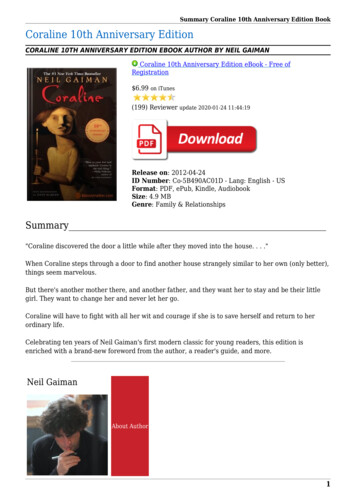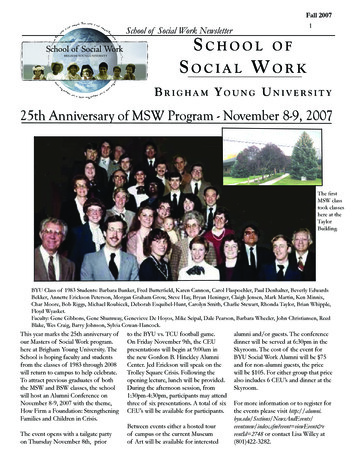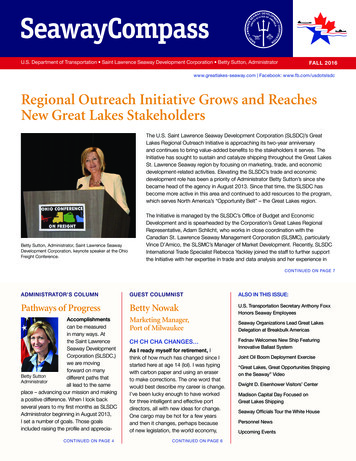
Transcription
SPECIAL EDITION: 10TH Anniversary Focus SeriesScienceTranslationalMedicine.org
Science Translational Medicine is an interdisciplinary journal that publishestranslational research with impact for human health that fills the knowledgegaps between preclinical studies and clinical applications.Chief Scientific AdvisorsElazer R. Edelman, M.D., Ph.D.Massachusetts Instituteof TechnologyGarret A. FitzGerald, M.D.University of PennsylvaniaEditorOrla M. Smith, Ph.D.Editorial TeamCatherine A. Charneski, Ph.D.Caitlin A. Czajka, Ph.D.Mattia Maroso, Ph.D.Melissa Norton, M.D.Yevgeniya Nusinovich, M.D., Ph.D.Lindsey Pujanandez, Ph.D.Scientific Advisory BoardJames Beeson, MB BS, Ph.D.Burnet InstituteWolfgang Bergmeier, Ph.D.University of North Carolina at Chapel HillSonja M. Best, Ph.D.National Institute of Allergy and InfectiousDiseases, National Institutes of HealthBruce Blazar, M.D.University of MinnesotaPadraic Fallon, Ph.D, D.Sc.Trinity Biomedical Sciences InstituteTrinity College DubliThomas Fehr, M.D.University of ZurichNeil Ferguson, Ph.D.Imperial College LondonMark C. Fishman, M.D.Harvard UniversityJeff Bluestone, Ph.D.UCSF Diabetes CenterScott L. Friedman, M.D.Mount Sinai School of MedicineOnur Boyman, M.D.University of ZurichUniversity Hospital ZurichSanjiv Sam Gambhir, M.D., Ph.D.Stanford University School of MedicineChristine Brown, Ph.D.City of HopeTania Bubela, J.D., Ph.D.Simon Fraser UniversityGeoffrey S. Ginsburg, M.D., Ph.D.Duke Institute for Genome Sciences & PolicyMithat Gönen, Ph.D.Memorial Sloan-Kettering Cancer CenterMartine D. Clozel, M.D.Actelion Pharmaceuticals Ltd.Jeffrey I. Gordon, M.D.Washington University in St. Louis,School of MedicineJacob Corn, Ph.D.ETH ZurichJ. Timothy Greenamyre, M.D., Ph.D.University of PittsburghGrégoire Courtine, Ph.D.Center for Neuroprosthetics and BrainMind Institute, Swiss Federal Institute ofTechnology (EPFL)Frank Harrell Jr., Ph.D.Vanderbilt University School of MedicineMichele De Palma, Ph.D.Ecole Polytechnique Fédérale deLausanne (EPFL)Swiss Federal Institute of Technology, LausanneSteven Deeks, M.D.University of California, San FranciscoSudhansu K. Dey, Ph.D.Cincinnati Children’s Hospital Medical CenterHarry C. Dietz, M.D.Johns Hopkins University School of MedicineGeorg N. Duda, Ph.D.Charité Universitätsmedizin, BerlinSabine A. Eming, M.D.University of CologneEric Hoffman, Ph.D.Reveragen BioPharmaBinghamton University – SUNYElaine Holmes, Ph.D.Imperial College LondonDavid Holtzman, M.D.Washington University School of MedicineKenya Honda, M.D. Ph.D.Keio University School of MedicineGökhan S. Hotamisligil, M.D., Ph.D.Harvard University, School of Public HealthSteven E. Hyman, M.D.Harvard Medical SchoolCarl H. June, M.D.University of PennsylvaniaStephen F. Kingsmore, MB, ChB, BAO,DSc, FRCPathRady Pediatric Genomic andSystems Medicine InstituteMarina Konopleva, M.D., Ph.D.The University of Texas MD AndersonCancer CenterRobert Langer, Ph.D.Massachusetts Institute of TechnologyElizabeth M. McNally, M.D., Ph.D.Northwestern UniversityLisa M. McShane, Ph.D.National Cancer Institute and National Institutesof HealthBernard Munos, MBA, M.S.InnoThink Center for Research inBiomedical InnovationGary Nabel, M.D., Ph.D.Sanofi-AventisCarl Nathan, M.D.Weill Cornell MedicineMarkus Neurath, M.D.University Hospital ErlangenNickolas Papadopoulos, Ph.D.The Johns Hopkins InstitutionsAlan R. Saltiel, Ph.D.University of California, San Diego Schoolof MedicineHelen Scharfman, Ph.D.New York University Neuroscience InstituteNew York University Langone HealthThe Nathan Kline Institute forPsychiatric ResearchPadmanee Sharma, M.D., Ph.D.The University of Texas MD AndersonCancer CenterNicholas Schiff, M.D.Weill Cornell Medical CollegeFu-Dong Shi, M.D., Ph.D.Tianjin Medical University General HospitalBeijing Tiantan HospitalCapital Medical UniversityGerald I. Shulman, M.D., Ph.D.Howard Hughes Medical InstituteYale UniversityBin Tean Teh, M.D., Ph.D.Duke-NUS Medical SchoolNational Cancer Centre of SingaporeEric J. Topol, M.D.Scripps Translational Science InstituteLeonard Petrucelli, Ph.D.Mayo Clinic College of MedicineLivio Trusolino, M.D., Ph.D.University of Torino School of MedicineCandiolo Cancer Institute – IRCCSKornelia Polyak, M.D., Ph.D.Harvard Medical SchoolGordana Vunjak-Novakovic, Ph.D.Columbia UniversityGlenn Prestwich, Ph.D.The University of UtahRalph Weissleder, M.D., Ph.D.Massachusetts General HospitalHarvard Medical SchoolRino Rappuoli, Ph.D.Novartis Vaccines and DiagnosticsJeremy N. Rich, M.D.,MHS, MBAUniversity of California, San DiegoJosé-Alain Sahel, M.D.Pierre and Marie Curie UniversityNational Eye HospitalINSERM-UPMC, University of PittsburghMedical Centerwww.SCIENCETRANSLATIONALMEDICINE.orgDavid S. Wilkes, M.D.University of Virginia School of MedicineTadataka (Tachi) Yamada, M.D.Frazier HealthcareKeith R. Yamamoto, Ph.D.University of California, San FranciscoElias Zerhouni, M.D.Sanofi-Aventis
SPECIAL EDITION:10th Anniversary Focus Series Science Transforming MedicineThe cover image shows a collection of Science Translational Medicinecovers, one for each year of the journal’s publication. To celebrateScience Translational Medicine’s 10th anniversary in 2019 and adecade of exciting translational research, the journal published aspecial Focus series “Science Transforming Medicine”. Focus articlesin this series highlight key translational research advances in different fields achieved since the journal began publishing in October2009. Authored by leading researchers, the Focus articles discussprogress over the past decade and the barriers still to be surmountedto translate these exciting translational advances into improvedtreatments for patients.Credit: Science Translational Medicine¾Publisher / Science familyof journals: Bill MoranAD/ Business Development:Justin SawyersMarketing Manager:Shawana ArnoldLayout/Design: Kim HuynhIN THIS BOOKLETFOCUS ARTICLES425 Transforming medicine with Applications of liquid biopsies for cancerthe microbiomeNiv Zmora, Eliran Soffer, and Eran Elinav71013 Driving CAR T cell translation forwardLiora Schultz and Crystal Mackall Advances in artificial pancreas systems16 Exacting Edward Jenner’s revenge:The quest for a new tuberculosis vaccineSteven A. Porcelli and William R. Jacobs Jr.treating blindnessJosé-Alain Sahel, Jean Bennett, and Botond Roska A decade of digital medicine innovationEric J. Topol Conformable bioelectronic interfaces:Mapping the road ahead Wrangling RNA: Antisenseoligonucleotides for neurologicaldisordersKevin Talbot and Matthew J. A. WoodCharlotte K. Boughton and Roman Hovorka Depicting brighter possibilities for192228 ustin K. Mattox, Chetan Bettegowda, Shibin Zhou,ANickolas Papadopoulos, Kenneth W. Kinzler,and Bert Vogelstein31 Multiple roles for HIV broadly3437neutralizing antibodiesBarton F. Haynes, Dennis R. Burton, and JohnR. Mascola Promising disease-modifying therapiesfor Parkinson’s diseaseValina L. Dawson and Ted M. Dawson Advances in clinical MRI technologyMukesh G. Harisinghani, Aileen O’Shea, andRalph WeisslederGiuseppe Schiavone and Stéphanie P. Lacourwww.SCIENCETRANSLATIONALMEDICINE.org 2020 by The American Associationfor the Advancement of Science.All Rights Reserved.
FOCUS ARTICLESSCIENCE TRANSLATIONAL MEDICINE FOCUS1 0 TH A N N I V E R S A R Y S E R I E STransforming medicine with the microbiomeNiv Zmora1,2,3*, Eliran Soffer1*, Eran Elinav1†Advances in microbiome research are spurring the development of new therapeutics for a variety of diseases, buttranslational challenges remain.The study of microorganisms has been revolutionized by complementing the centuriesold art of microbiology with next-generationsequencing of complex bacterial communities(collectively termed “the microbiome”) withinand around the eukaryotic host. Microbiomeresearch initially focused on associations between certain microbial compositional features and human medical conditions. The fieldhas quickly evolved, unraveling causative linksbetween distinct microbial consortia, their collective functions, and impacts on host pathophysiology. In addition to the microbiome’semerging role as an orchestrator of biological processes, it also has plasticity in its composition and function, thereby constitutingan attractive target for therapeutic intervention. In this Focus, the first in a special seriesto celebrate the 10th anniversary of ScienceTranslational Medicine, we introduce a paperpublished in the journal a decade ago anddiscuss progress in developing translationalapproaches involving the host-microbiomeinterface (Fig. 1).HOST-MICROBIOME MODULATIONBY DIETFor decades, nutritional research focused onseeking direct links between dietary constituents and human health, aiming to establishuniversal guidelines to combat disease. However, a large body of research has not resultedin conclusive findings, contributing to various unsubstantiated nutritional trends and unsupported practices. Gut microbiome studieshave added an important facet to nutritionalresearch by incorporating the microbiome asa major contributor to host metabolic phenotypes, thus clarifying some of the unresolvedquestions in the field. In their pioneering workpublished a decade ago, Turnbaugh et al. (1)showed that host adiposity could be modulated by the gut microbiome’s ability to har-vest energy from food; transplantation ofmicrobiome consortia obtained from lean orgenetically obese mice into germ-free micetransferred the donor’s phenotype to the recipient animal. In subsequent work publishedin Science Translational Medicine (2), theseinvestigators demonstrated in germ-free micetransplanted with fecal microbiomes fromhuman volunteers that microbiome composition and function could be rapidly and reproducibly altered by diet. These discoverieshave led to potential approaches to treat cardiometabolic disease, and attempts have beenmade to find prebiotic dietary componentsto shape the microbiome and confer healthbenefits on the host. An example of such prebiotic intervention was described by Zhao et al.(3); they showed that dietary fiber intakeimproved glycemic control in patients withtype 2 diabetes mellitus to a greater extentthan standard care through modulation of themicrobiome. With these examples of “onesize fits all” nutritional interventions notwithstanding, heterogeneity among individuals in gut microbiome composition andfunction is increasingly appreciated to hamper universal food-based interventions. Accordingly, Zeevi et al. (4) showed that glycemicresponses to food were person specific anddictated by a combination of clinical, laboratory, and microbiome characteristics. Individual postprandial glycemic responses becamepredictable with a machine-learning algorithm,enabling personalized diets that maintainednormoglycemia.In the next decade, microbiome-based dietary and prebiotic interventions may emergeas essential tools for health care and dietaryplanning, enabling precision therapies, forexample, as a complementary preventivetreatment of uncontrolled inflammation ininflammatory bowel disease (IBD). Fecal microbiome profiling could become a componentof medical evaluation, leading to tailor-made1Immunology Department, Weizmann Institute of Science, Rehovot 7610001, Israel. 2Digestive Center, Tel AvivSourasky Medical Center, Tel Aviv 6423906, Israel. 3Internal Medicine Department, Tel Aviv Sourasky MedicalCenter, Tel Aviv 6423906, Israel.*These authors contributed equally to this work.†Corresponding author. Email: eran.elinav@weizmann.ac.ilZmora et al., Sci. Transl. Med. 11, eaaw1815 (2019)4Copyright 2019The Authors, somerights reserved;exclusive licenseeAmerican Associationfor the Advancementof Science. No claimto original U.S.Government Worksdiets or ad hoc medications. However, conclusive evidence of prebiotic and personalizeddiets as inducers of sustained metabolic improvements in humans still remains to be determined. Future studies should concentrateon long-term impacts and safety of such therapies and on their potential extension to healthconditions beyond obesity and its metaboliccomplications, such as malnutrition, dietaryconstituent deficiencies, inflammatory states,and neoplastic diseases.HOST-MICROBIOME MODULATIONBY PROBIOTICSBacterial supplements, termed probiotics, havebeen used to promote health for more than acentury, yet their efficacy remains inconclusive.Gut microbiome research offers an opportunity to study live microbial interventions interms of colonization, interactions with theindigenous microbiome, and impact on thehost. Recent work (5) suggests that some inconsistencies regarding live microbial effectson the human host might stem from interindividual differences in probiotic gut colonization patterns and their impact on theindigenous microbiome. As “resistance” and“permissiveness” to probiotic gut mucosalcolonization could be predicted by baselinehost and microbiome features, an opportunity emerges for context-specific tailoring ofdistinct probiotic strains to optimize gut colonization and downstream activity.There are still major obstacles to implementing live microbial therapy in clinicalpractice. These challenges include the needto develop noninvasive approaches for directsampling of the gut mucosa and technologiesto enable reliable characterization of the microbiome in different regions of the gut. Inaddition, we need to determine mechanismsof activities of probiotic strains in vivo, thereby enabling the prediction of alterations in themicrobiome after treatment. Last, we need togenerate high-quality and conclusive clinicaldata in the form of large multicenter randomized, placebo-controlled trials in different clinical scenarios and human subpopulations.1 of 330 January 2019www.SCIENCETRANSLATIONALMEDICINE.org30 January 2019Vol 11 Issue 477 aaw1815
FOCUS ARTICLESSCIENCE TRANSLATIONAL MEDICINE agetherapyOHOHOOO–Barrier functionmodulationOHOPostbioticsFig. 1. Gut microbiome–based therapeutic approaches. Recent research has elucidated gut microbiome interventions for promoting human health and for combating disease. These approaches include microbiome modulation ordirect impact on the host through nutritional intervention, either by prebiotics or by individualized diets (top left).Strategies to affect the gut microbiome or directly impact the host through live bacteria supplementation or exclusion include fecal microbiome transplantation (FMT), treatment with custom-made probiotics, or targeted eliminationof bacterial members of the microbiome (top right). The host and potentially its microbiome can also be modulatedby administration, reduction, or activity blocking of bacteria-derived metabolites through treatment with or inhibition of postbiotics (bottom right) or by manipulation of host gut barrier function (bottom left). Collectively, thesemodalities, when used alone or in combinations, will affect the host-microbiome interface.CREDIT: A. KITTERMAN/SCIENCE TRANSLATIONAL MEDICINEHOST-MICROBIOME MODULATION BYBACTERIAL METABOLITESAnother strategy for microbiome-based therapies is to use supplements of bacteria-derivedmetabolites or to block their generation, rather than attempting to enrich or deplete thebacteria that produce them. One example ofthese so-called “postbiotics” was described byMaslowski et al. (6). They showed that shortchain fatty acids produced by fermentation ofdietary fiber by the gut microbiome or thoseadministered exogenously could attenuategut inflammation in mouse models of colitis.In animal models of recurrent obesity, diminished flavonoids from an altered microbiomedrove exaggerated weight regain after successful dieting (7). Postbiotic replenishmentof the depleted metabolites mitigated theaccelerated weight regain by affecting adipocyte energy expenditure. Similarly, Koeth et al.Zmora et al., Sci. Transl. Med. 11, eaaw1815 (2019)(8) revealed that the gut microbiome metabolizes l-carnitine, a compound abundant inred meat, into the proatherogenic moleculetrimethylamine N-oxide. Follow-up studieshave tested inhibitors targeting a gut microbial enzyme in this pathway to combat platelet hyperreactivity and to decrease the risk ofatherothrombotic events, such as myocardialinfarction and stroke. Together, these findingshighlight the potential of postbiotic therapywith microbiome-derived molecules in animal models. Additional studies are warrantedto shed light on the intended and off-targeteffects of such compounds and to examinetheir long-term safety in humans.HOST-MICROBIOME MODULATION BY FMTOne of the oldest microbiome-based interventions in humans, which dates back to thefourth century, is fecal microbiometransplantation (FMT). In a landmarkstudy, van Nood et al. (9) found that intraduodenal infusion of a healthy fecalmicrobiome administered to patients suffering from recurrent Clostridium difficileinfection decreased the rate of infectionrecurrence within 10 weeks of follow-upcompared to treatment with the antibioticvancomycin. Since then, FMT has beenstudied in other disease contexts, suchas cardiometabolic disease and IBD. Oneemerging limitation of FMT is that efficacyvaries between fecal donors because of unknown factors. Another concern involvesthe risk of transmission of communicablediseases or other microbiome-mediatedtraits from donor to recipient.An alternative, more personalized approach involves an autologous FMT usingfecal samples from the individual that werebanked before disease onset. Such an approach would necessitate large-scale fecalbanking facilities. However, it still carriesunderlying risks, as microbiomes from individuals who may appear healthy couldharbor causal factors of the condition to betreated, resulting in unforeseen resurgenceof the disease. Future studies should investigate the factors that render some FMTdonors superior to others, decipher theinteractions between the transplanted andhost microbiomes, and elucidate gut colonization. New mechanistic insights couldenable development of “designer” therapies of custom-made microbiome signatures conferring distinct functions.TARGETED ELIMINATION AND GUTBARRIER REGULATIONOne unmet need is an intervention that specifically eliminates harmful members of themicrobiome (pathobionts) from the ecosystem. Although antibiotics are commonly usedagainst pathogens, they are nonspecific, inflict collateral damage both to commensalbacteria and to the host, and are associatedwith the emergence of antibiotic-resistant bacterial strains. Bacteriophages are now attracting renewed attention because they can targetspecific bacteria and result in fewer side effects than antibiotics due to their lack of tropism for eukaryotic cells. Norman et al. (10)showed that patients with IBD exhibited abnormal enteric viromes with an increasedrichness of bacteriophages. Exogenous administration of lytic bacteriophage combinationsor designer nanomolecular structures that2 of 330 January 2019www.SCIENCETRANSLATIONALMEDICINE.org30 January 2019Vol 11 Issue 477 aaw18155
FOCUS ARTICLESSCIENCE TRANSLATIONAL MEDICINE FOCUSuse bacterial recognition sites and phageassociated membrane penetration machinerycould serve as a strain-specific pathobionttargeting modality. Although having greatpotential, bacteriophage therapy faces majorchallenges, including an inability to recapitulate in vitro antibacterial action in vivo. Thiscould be attributable to dosing issues, phagemutagenesis, interaction with the microbiome, neutralization by host antibodies, or theemergence of phage-resistant bacterial strains.Combinations of phages targeting distinct receptors on pathobionts of interest may offera solution to some of these issues.Another underexplored methodology toregulate host-microbiome interactions andmicrobial immunomodulatory products liesin direct targeting of the host intestinal barrier.Emerging regulators of gut barrier functioninclude biophysical factors such as osmoticpressure, microbiome-generated molecules,and host-related modulators. Comprehensiveunderstanding of the repertoire and mechanisms of these barrier-modulating factors isan exciting avenue of future research.CHALLENGES AND PROSPECTSThe last decade has witnessed a remarkableleap in microbiome research. In its infancy,such research focused on important but inherently limited descriptive studies, providing a detailed characterization of microbiomealterations during health and disease and inresponse to distinct dietary regimens. Thesestudies are now being followed by more mechanistic approaches to establish causal links between microbiome assemblages and variousphenotypes. A new and exciting aspect of microbiome research focuses on personalization of interventions, as well as harnessing theinherent individualized variability in microbiomes and other physiological features toexplain and even predict human health anddisease states.In addition to the specific challenges presented so far, there are some general limitations to be considered when attempting todraw clinical conclusions from gut microbiome research. Conceptual pitfalls include distinguishing between associative and causativerelationships, which should be validated byappropriate experimentation. This could beaccomplished by ablation of the disease phenotype after antibiotic treatment or by mimicking the phenotype with the administrationof a postbiotic compound. The ideal validationwould reproduce the phenotype by transplanZmora et al., Sci. Transl. Med. 11, eaaw1815 (2019)6tation of different microbiome configurationsinto germ-free mice. It is crucial to account fordifferences between preclinical models andhumans in terms of anatomy, physiology, andmicrobiome composition. Humans tend tohave more heterogeneous microbiomes thando animal models because of variations in geographic, ethnic, and nutritional backgroundsand thus manifest a wider spectrum of phenotypes. In addition, nonbacterial members ofthe microbiome, such as the virome, mycome,and parasitome, are currently understudiedbut are increasingly recognized to mediateimportant regulatory functions in the hostgut. Furthermore, with the development oftechniques to handle low-biomass samples,other organs such as the skin, genitourinary tract, and respiratory tract are beingexplored as treatment targets. Last, severaltechnical challenges need to be addressed,such as establishing standardized protocolsfor sample collection, storage, processing, sequencing and analysis, and harmonization ofinterpretation.Clinical translation necessitates stringenttesting, preferably in the form of randomizedplacebo-controlled clinical trials. In these trials,feasibility, efficacy, adverse events, and longterm safety issues need to be assessed in largecohorts to ensure that the tested interventionsare used responsibly, avoiding unsubstantiatedclaims and contemporary hype. As part ofthe process, regulatory authorities, such as theU.S. Food and Drug Administration and theEuropean Food Safety Authority, will haveto adapt their procedures to accommodatenew data mining techniques such as machinelearning and artificial intelligence, while enabling the testing of microbial and metaboliteconsortia, rather than individual componentsof consortia. Uniform, rigorous, and unbiasedexperimental and regulatory approaches, similar to the careful and stringent testing andapproval processes practiced in other humaninterventions, will allow the safe and efficacious long-term integration of microbiomebased therapies into the treatment of a varietyof different diseases.REFERENCES AND NOTES1. P. J. Turnbaugh, R. E. Ley, M. A. Mahowald, V. Magrini,E. R. Mardis, J. I. Gordon, An obesity-associated gutmicrobiome with increased capacity for energy harvest.Nature 444, 1027–1031 (2006).2. P. J. Turnbaugh, V. K. Ridaura, J. J. Faith, F. E. Rey,R. Knight, J. I. Gordon, The effect of diet on the humangut microbiome: A metagenomic analysis in humanizedgnotobiotic mice. Sci. Transl. Med. 1, 6ra14 (2009).3. L. Zhao, F. Zhang, X. Ding, G. Wu, Y. Y. Lam, X. Wang,H. Fu, X. Xue, C. Lu, J. Ma, L. Yu, C. Xu, Z. Ren, Y. Xu, S. Xu,H. Shen, X. Zhu, Y. Shi, Q. Shen, W. Dong, R. Liu, Y. Ling,Y. Zeng, X. Wang, Q. Zhang, J. Wang, L. Wang, Y. Wu,B. Zeng, H. Wei, M. Zhang, Y. Peng, C. Zhang, Gutbacteria selectively promoted by dietary fibers alleviatetype 2 diabetes. Science 359, 1151–1156 (2018).4. D. Zeevi, T. Korem, N. Zmora, D. Israeli, D. Rothschild,A. Weinberger, O. Ben-Yacov, D. Lador, T. Avnit-Sagi,M. Lotan-Pompan, J. Suez, J. A. Mahdi, E. Matot,G. Malka, N. Kosower, M. Rein, G. Zilberman-Schapira,L. Dohnalova, M. Pevsner-Fischer, R. Bikovsky,Z. Halpern, E. Elinav, E. Segal, Personalized nutrition byprediction of glycemic responses. Cell 163, 1079–1094(2015).5. N. Zmora, G. Zilberman-Schapira, J. Suez, U. Mor,M. Dori-Bachash, S. Bashiardes, E. Kotler, M. Zur,D. Regev-Lehavi, R. B. Brik, S. Federici, Y. Cohen,R. Linevsky, D. Rothschild, A. E. Moor, S. Ben-Moshe,A. Harmelin, S. Itzkovitz, N. Maharshak, O. Shibolet,H. Shapiro, M. Pevsner-Fischer, I. Sharon, Z. Halpern,E. Segal, E. Elinav, Personalized gut mucosalcolonization resistance to empiric probiotics isassociated with unique host and microbiome features.Cell 174, 1388–1405.e21 (2018).6. K. M. Maslowski, A. T. Vieira, A. Ng, J. Kranich, F. Sierro,D. Yu, H. C. Schilter, M. S. Rolph, F. Mackay, D. Artis,R. J. Xavier, M. M. Teixeira, C. R. Mackay, Regulation ofinflammatory responses by gut microbiota andchemoattractant receptor GPR43. Nature 461,1282–1286 (2009).7. C. A. Thaiss, S. Itav, D. Rothschild, M. Meijer, M. Levy,C. Moresi, L. Dohnalová, S. Braverman, S. Rozin,S. Malitsky, M. Dori-Bachash, Y. Kuperman, I. Biton,A. Gertler, A. Harmelin, H. Shapiro, Z. Halpern,A. Aharoni, E. Segal, E. Elinav, Persistent microbiomealterations modulate the rate of post-dieting weightregain. Nature 540, 544–551 (2016).8. R. A. Koeth, Z. Wang, B. S. Levison, J. A. Buffa, E. Org,B. T. Sheehy, E. B. Britt, X. Fu, Y. Wu, L. Li, J. D. Smith,J. A. DiDonato, J. Chen, H. Li, G. D. Wu, J. D. Lewis,M. Warrier, J. M. Brown, R. M. Krauss, W. H. Tang,F. D. Bushman, A. J. Lusis, S. L. Hazen, Intestinalmicrobiota metabolism of L-carnitine, a nutrient in redmeat, promotes atherosclerosis. Nat. Med. 19, 576–585(2013).9. E. van Nood, A. Vrieze, M. Nieuwdorp, S. Fuentes,E. G. Zoetendal, W. M. de Vos, C. E. Visser, E. J. Kuijper,J. F. Bartelsman, J. G. Tijssen, P. Speelman,M. G. Dijkgraaf, J. J. Keller, Duodenal infusion of donorfeces for recurrent Clostridium difficile. N. Engl. J. Med.368, 407–415 (2013).10. J. M. Norman, S. A. Handley, M. T. Baldridge, L. Droit,C. Y. Liu, B. C. Keller, A. Kambal, C. L. Monaco, G. Zhao,P. Fleshner, T. S. Stappenbeck, D. P. McGovern,A. Keshavarzian, E. A. Mutlu, J. Sauk, D. Gevers,R. J. Xavier, D. Wang, M. Parkes, H. W. Virgin,Disease-specific alterations in the enteric virome ininflammatory bowel disease. Cell 160, 447–460(2015).Acknowledgments: We thank the members of the Elinavlaboratory for helpful discussions. E.E. is a paid consultant atDayTwo and BiomX.10.1126/scitranslmed.aaw1815Citation: N. Zmora, E. Soffer, E. Elinav, Transforming medicinewith the microbiome. Sci. Transl. Med. 11, eaaw1815 (2019).3 of 330 January 2019www.SCIENCETRANSLATIONALMEDICINE.org30 January 2019Vol 11 Issue 477 aaw1815
FOCUS ARTICLESSCIENCE TRANSLATIONAL MEDICINE FOCUS1 0 TH A N N I V E R S A R Y S E R I E SDriving CAR T cell translation forwardLiora Schultz1 and Crystal Mackall1,2,3*Successes in CAR T cell translation have propelled their commercial launch, but expanding the impact of cancerimmunotherapies remains challenging.Adoptive cell therapy for cancer has beenrevolutionized by the development of chimeric antigen receptor (CAR) T cells. CARsare synthetic T cell receptors that fuse tumorspecific binding domains to T cell activationsignals to confer tumor-specific cytotoxicity.Patient-derived T cells can be collected andtransduced ex vivo to express CARs and thenreturned to the patient to mediate tumoreradication. Following decades of preclinical development, striking clinical responseshave been achieved using CAR T cells targeting CD19, a B cell antigen with conservedexpression by the majority of B cell malignancies. The success of CD19-CAR T cellshas propelled commercial launch of thisclass of therapeutics, but realizing the fullpotential of CAR T cells will require parallelscientific progress to overcome primary andsecondary resistance and addressing practical challenges relating to affordability andscalability (Fig. 1).DISCOVERING CAR T CELL POTENCYIn addition to a successful trial in indolentlymphoma, an early report of CAR T cellefficacy in patients with chronic lymphocyticleukemia (CLL) by Kalos et al. (1) was published in Science Translational Medicine. Thesestudies demonstrated that CD19-CAR T cellscould induce lasting antitumor responsesand establish CAR memory T cells. Subsequent results in pediatric and adult acutelymphoblastic leukemia (ALL) revealed exquisite sensitivity to CD19-CAR T cell therapy, driving global collaborative efforts tocentralize manufacturing and confirm results at scale. A phase 2 multi-institutionaltrial testing CD19-specific CAR T cells inpediatric patients and young adults reporteda remission rate of 81% within 3 months ofinfusion in the subset of patients for whomex vivo T cell engineering was successful andwhose clinical status was such that they couldwait for manufacture of the T cell product(2). This led the U.S. Food and Drug Administration (FDA) in 2017 to approve tisagenlecleucel, a CD19-specific 4-1BB- CARconstruct for treating relapsed or refractoryCD19 B cell ALL in children and youngadults. Shortly thereafter came FDA approvalof axicabtagene ciloleucel, a CD19-specificCD28- CAR construct, for treating refractory large B cell lymphoma after a phase 2multi-institutional study in adults, whichdemonstrated complete responses in 54% ofpatients (3). Thus, i
Cancer Center Nicholas Schiff, M.D. Weill Cornell Medical College Fu-Dong Shi, M.D., Ph.D. Tianjin Medical University General Hospital Beijing Tiantan Hospital Capital Medical University Gerald I. Shulman, M.D., Ph.D. Howard Hughes Medical Institute Yale University Bin Tean Teh, M.D., Ph.D. Duke-NUS Medical School National Cancer Centre of .










